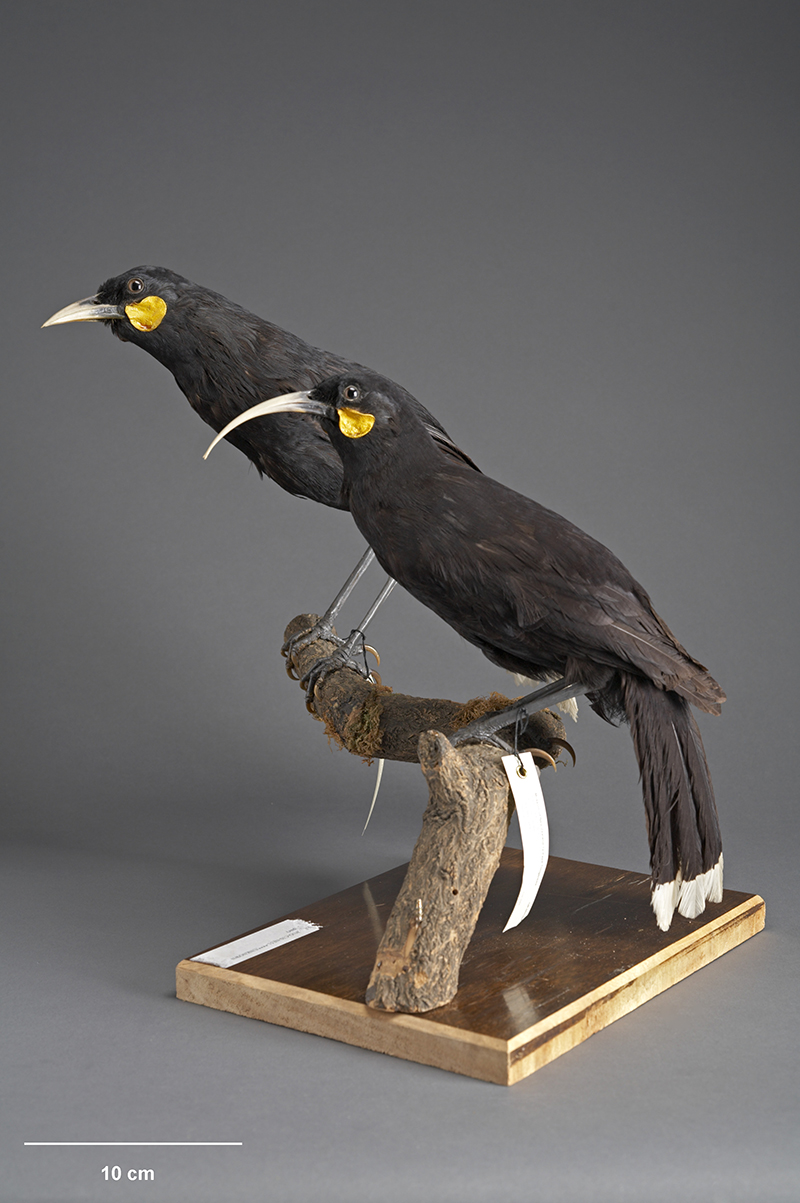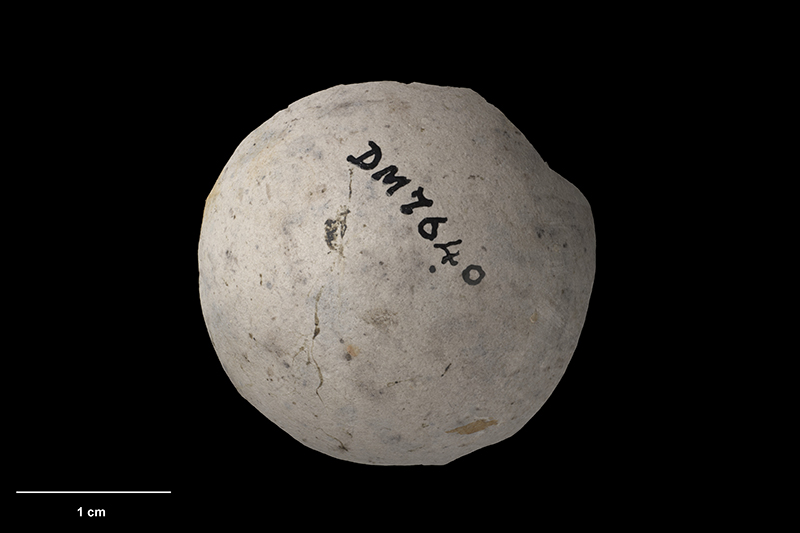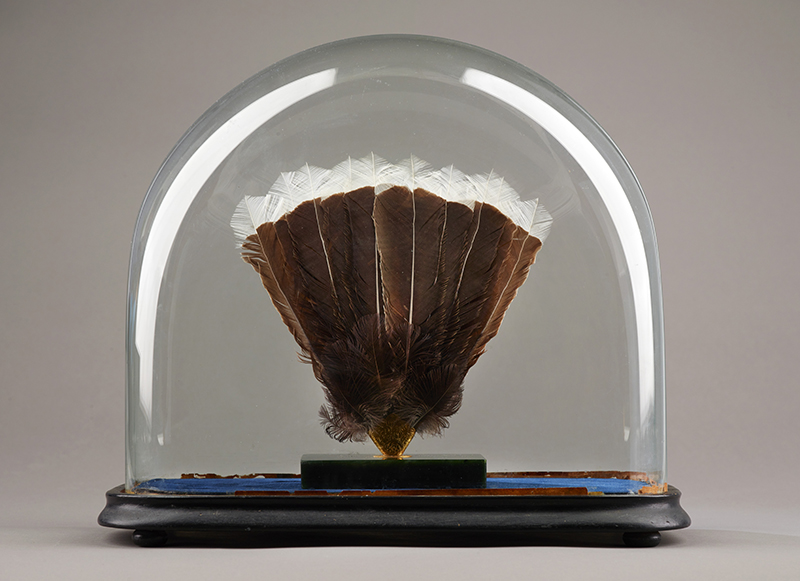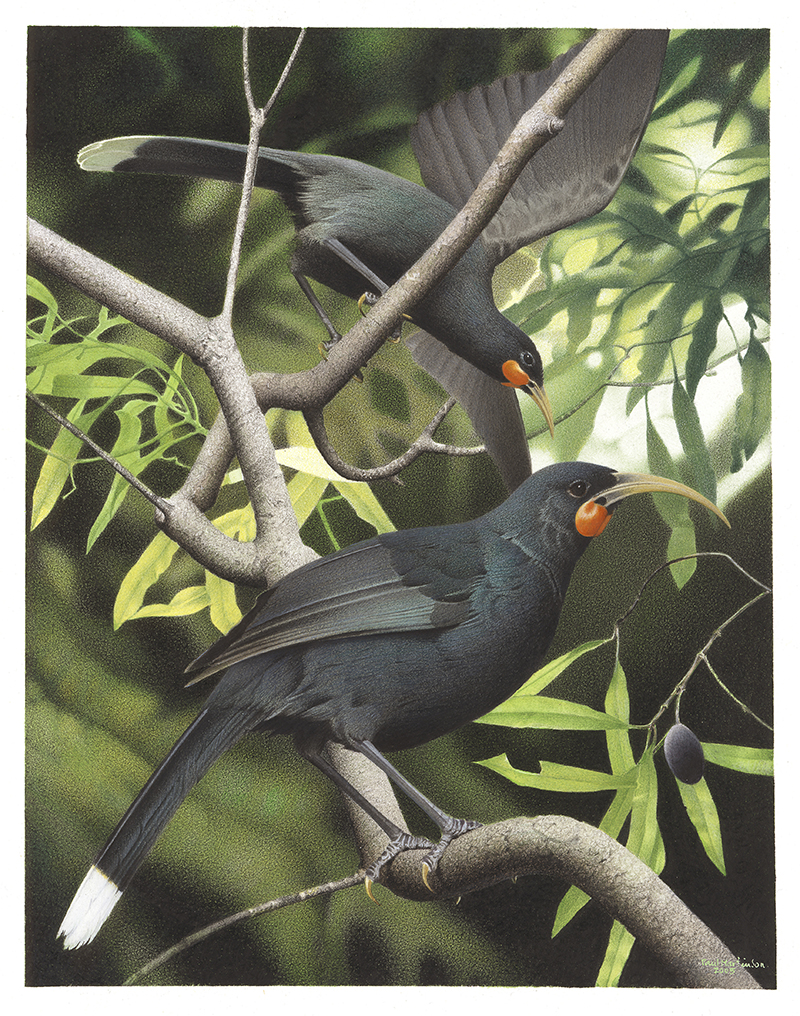Heteralocha acutirostris Gould, 1837
Huia
Taxonomy & Nomenclature
A complete synonymy taken from (Checklist Committee (OSNZ), 2022:209):
Neomorpha acutirostris Gould, 1837: Synop. Birds Australia 1: pl. 11 & text – North Island.; Heteralocha acutirostris (Gould); Buller 1872 (Apr.), History of the Birds of N.Z., 1st edition (part 1): 63.; Heteralocha auctirostris (Gould); Enys 1876, Trans. Proc. N.Z. Inst. 8: 204. Misspelling.; Neomorpha crassirostris Gould, 1837: Synop. Birds Australia 1: pl. 11 & text – North Island.; Neomorpha Gouldii G.R. Gray, 1841: List Gen. Birds (2nd edition): 15. Unnecessary nomen novum for Neomorpha acutirostris Gould, 1837.; Heteralocha Gouldi (G.R. Gray); Cabanis 1851, Mus. Heineanum 1: 218. Unjustified emendation.; Heteralocha gouldi (G.R. Gray); G.R. Gray 1862, Ibis 4: 217. Unjustified emendation.; Heteralocah acutirostris Gould, 1837 (orthological error, table S1 from Dussex et al., 2019); Heterolocha acutirostris Gould, 1837 [orth. error used by (Knox & Walters, 1994:271)]
Conservation Status
Extinct (WCMC, 1992:213)
Last record: 1905(?) (Galbreath, 2017); 1907 (Myers, 1923; WCMC, 1992:213; Tyrberg, 2009:103; Kittelberger et al., 2024) (unconfirmed: Galbreath, 2017); 1925? (Tyrberg, 2009:103); 1961 (Higgins et al., 2006)
IUCN RedList status: Extinct
Distribution
North Island, New Zealand
Biology & Ecology
Hypodigm
Naturalis, Leiden:
RMNH 110.080 (male)
RMNH 110.081 (female)
RMNH 110.101 (male)
RMNH 110.102 (female)
RMNH 110.107 (female)
RMNH 110.108 (male)
RMNH 110.109 (female)
Moorhouse (1996) analysed 30 skins held in collections in New Zealand. Houston (2010) reported that he had examined 23 skins from the Natural History Museum at Tring.
http://www.aucklandmuseum.com/collections-research/collections/search/?pht=True&k=Huia&dept=birds%2fland+vertebrates
The Whanganui Regional Museum, North Island, New Zealand has at least one specimen ([url=https://www.nzherald.co.nz/history/news/article.cfm?c_id=500832&objectid=12088958]source[/ur]).
Museum of New Zealand Te Papa Tongarewa:
ME022341 (feathers; link includes photos)
ME022354/1 (feather; link includes photos)
ME023837 (feather; link includes photos)
ME024123 (feather; link includes photos)
OR.000096 (link includes photo of specimen)
OR.001328 (link includes photo of specimen)
OR.005514 (link includes photo of specimen)
OR.005516 (link includes photo of specimen)
OR.005526 (link includes photo of specimen)
OR.005533 (link includes photo of specimen)
OR.007640 (collected 11 October 1877; the only known egg)
OR.008514 (link includes photo of specimen)
OR.008561 (link includes photo of specimen)
OR.011063 (link includes photo of specimen)
OR.022790 (link includes photo of specimen)
OR.025278 (link includes photo of specimen)
OR.026535 (link includes photo of specimen)
OR.027624 (link includes photo of specimen)
OR.030203 (link includes photo of specimen)
Media

Above: Huia, Heteralocha acutirostris, collected no data, New Zealand. Acquisition history unknown. CC BY 4.0. Te Papa (OR.000064)

Above: Huia, Heteralocha acutirostris, collected no data, New Zealand. Acquisition history unknown. CC BY 4.0. Te Papa (OR.000064)

Above: Huia, Heteralocha acutirostris, collected no data, New Zealand. Purchased 1916. CC BY 4.0. Te Papa (OR.000152)

Above: Huia, Heteralocha acutirostris, collected no data, New Zealand. Purchased 1916. CC BY 4.0. Te Papa (OR.000152)

Above: Huia, Heteralocha acutirostris, collected 1911, no data, New Zealand. CC BY 4.0. Te Papa (OR.000177)

Above: Huia, Heteralocha acutirostris, collected no data, New Zealand. CC BY 4.0. Te Papa (OR.001327)

Above: Huia, Heteralocha acutirostris, collected no data, New Zealand. CC BY 4.0. Te Papa (OR.010868)

Above: Huia, Heteralocha acutirostris, collected 1899, Makara, Wellington, New Zealand. Gift of Mr L.J. Vangioni, 1942. CC BY 4.0. Te Papa (OR.011056)

Above: Huia, Heteralocha acutirostris, collected no data, New Zealand. CC BY 4.0. Te Papa (OR.015791)

Above: Huia, Heteralocha acutirostris, collected no data, New Zealand. Acquisition history unknown. CC BY 4.0. Te Papa (OR.025277)

Above: Huia, Heteralocha acutirostris, collected 11 October 1877, Wainuiomata, New Zealand. Gift of Sir Walter Buller, 1877. CC BY 4.0. Te Papa (OR.007640)
Ornamental Use:

Above: Huia beak brooch, circa 1900, New Zealand, by Samuel Henry Drew. Gift of Mrs I. Ashby, 1983. CC BY-NC-ND 4.0. Te Papa (GH003375)

Above: Huia beak brooch, circa 1900, New Zealand, maker unknown. Purchased 1996 with New Zealand Lottery Grants Board funds. CC BY-NC-ND 4.0. Te Papa (GH005020)

Above: Huia beak brooch, circa 1900, New Zealand, maker unknown. Purchased 1996 with New Zealand Lottery Grants Board funds. CC BY-NC-ND 4.0. Te Papa (GH005020)

Above: Huia beak brooch, circa 1900, New Zealand, maker unknown. Purchased 1996 with New Zealand Lottery Grants Board funds. CC BY-NC-ND 4.0. Te Papa (GH005020)

Above: Huia beak brooch, circa 1900, New Zealand, maker unknown. Purchased 1996 with New Zealand Lottery Grants Board funds. CC BY-NC-ND 4.0. Te Papa (GH005020)

Above: Huia tail feathers, mounted on gold and pounamu., circa 1900, New Zealand, maker unknown. Purchased 2012. CC BY-NC-ND 4.0. Te Papa (GH023755)

Above: Huia tail feathers, mounted on gold and pounamu., circa 1900, New Zealand, maker unknown. Purchased 2012. CC BY-NC-ND 4.0. Te Papa (GH023755)

Above: Huia tail feathers, mounted on gold and pounamu., circa 1900, New Zealand, maker unknown. Purchased 2012. CC BY-NC-ND 4.0. Te Papa (GH023755)

Above: Huia tail feathers, mounted on gold and pounamu., circa 1900, New Zealand, maker unknown. Purchased 2012. CC BY-NC-ND 4.0. Te Papa (GH023755)
Sketches and paintings (pre-extinction):

Above: Huia head. (Heteralocha acutirostris), 1865 -1885, by John Buchanan. Te Papa (1992-0035-2279/52)

Above: Old male Huia . Young female Huia, 1865-1885, by John Buchanan. Te Papa (1992-0035-2279/64)

Above: Head of Huia, by John Buchanan. Te Papa (1992-0035-2279/65)

Above: Heteralocha acutirostris. Plate 8. From the book A history of the birds of New Zealand., 1873, by Johannes Keulemans. Te Papa (RB001176/008a)

Above: Three huia (Heteralocha acutirostris), circa 1900, London, by Johannes Keulemans. Purchased 1993 with New Zealand Lottery Grants Board funds. Te Papa (1993-0029-6)
Paintings (post-extinction):
A painting of two Huia by George Lodge (1913-1914) is in the Te Papa collection.

Above: Huia. Heteralocha acutirostris. From the series: Extinct Birds of New Zealand., 2005, Masterton, by Paul Martinson. Purchased 2006. © Te Papa. CC BY-NC-ND 4.0. Te Papa (2006-0010-1/11)
Huia specimens in Te Papa:
https://collections.tepapa.govt.nz/object/533988
https://collections.tepapa.govt.nz/object/533981
https://collections.tepapa.govt.nz/object/534051
https://collections.tepapa.govt.nz/object/1429216
https://collections.tepapa.govt.nz/object/1429209
https://collections.tepapa.govt.nz/object/725118
https://collections.tepapa.govt.nz/object/533939
https://collections.tepapa.govt.nz/object/533944
https://collections.tepapa.govt.nz/object/534017
https://collections.tepapa.govt.nz/object/534040
https://collections.tepapa.govt.nz/object/534134
https://collections.tepapa.govt.nz/object/534160
https://collections.tepapa.govt.nz/object/534143
https://collections.tepapa.govt.nz/object/534149
https://collections.tepapa.govt.nz/object/533995
https://collections.tepapa.govt.nz/object/533998
https://collections.tepapa.govt.nz/object/534013
https://collections.tepapa.govt.nz/object/534057
https://collections.tepapa.govt.nz/object/534167
https://collections.tepapa.govt.nz/object/534173
https://collections.tepapa.govt.nz/object/534178
https://collections.tepapa.govt.nz/object/1429356
https://collections.tepapa.govt.nz/object/1429352
https://collections.tepapa.govt.nz/object/1429350
https://collections.tepapa.govt.nz/object/1429212
https://collections.tepapa.govt.nz/object/534035
https://collections.tepapa.govt.nz/object/533982
https://collections.tepapa.govt.nz/object/534055
https://collections.tepapa.govt.nz/object/534130
https://collections.tepapa.govt.nz/object/534146
https://collections.tepapa.govt.nz/object/534147
https://collections.tepapa.govt.nz/object/534150
https://collections.tepapa.govt.nz/object/534177
https://collections.tepapa.govt.nz/object/366470
https://collections.tepapa.govt.nz/object/364757
https://collections.tepapa.govt.nz/object/364724
https://collections.tepapa.govt.nz/object/533943
https://collections.tepapa.govt.nz/object/533983
https://collections.tepapa.govt.nz/object/534174
https://collections.tepapa.govt.nz/object/534206
https://collections.tepapa.govt.nz/object/533983
https://collections.tepapa.govt.nz/object/534058
https://collections.tepapa.govt.nz/object/534164
https://collections.tepapa.govt.nz/object/1430232
https://collections.tepapa.govt.nz/object/712957
https://collections.tepapa.govt.nz/object/1429353
https://collections.tepapa.govt.nz/object/1429349
https://collections.tepapa.govt.nz/object/1429210
https://collections.tepapa.govt.nz/object/1429357
https://collections.tepapa.govt.nz/object/725123
https://collections.tepapa.govt.nz/object/640933
https://collections.tepapa.govt.nz/object/534100
https://collections.tepapa.govt.nz/object/534102
https://collections.tepapa.govt.nz/object/534103
https://collections.tepapa.govt.nz/object/533985
https://collections.tepapa.govt.nz/object/534159
https://collections.tepapa.govt.nz/object/534162
https://collections.tepapa.govt.nz/object/534136
https://collections.tepapa.govt.nz/object/534137
https://collections.tepapa.govt.nz/object/534152
https://collections.tepapa.govt.nz/object/534170
https://collections.tepapa.govt.nz/object/534175
https://collections.tepapa.govt.nz/object/366486
https://collections.tepapa.govt.nz/object/1429963
https://collections.tepapa.govt.nz/object/641070
https://collections.tepapa.govt.nz/object/641026
https://collections.tepapa.govt.nz/object/1430216
https://collections.tepapa.govt.nz/object/641022
https://collections.tepapa.govt.nz/object/641019
https://collections.tepapa.govt.nz/object/641041
https://collections.tepapa.govt.nz/object/534126
https://collections.tepapa.govt.nz/object/700783
https://collections.tepapa.govt.nz/object/641017
https://collections.tepapa.govt.nz/object/1430218
https://collections.tepapa.govt.nz/object/514682
https://collections.tepapa.govt.nz/object/1429962
https://collections.tepapa.govt.nz/object/514680
https://collections.tepapa.govt.nz/object/725107
https://collections.tepapa.govt.nz/object/725129
https://collections.tepapa.govt.nz/object/422813
https://collections.tepapa.govt.nz/object/1602938
https://collections.tepapa.govt.nz/object/725076
https://collections.tepapa.govt.nz/object/360821
https://collections.tepapa.govt.nz/object/617585
https://collections.tepapa.govt.nz/object/725079
https://collections.tepapa.govt.nz/object/1429208
https://collections.tepapa.govt.nz/object/201138
https://collections.tepapa.govt.nz/object/700592
https://collections.tepapa.govt.nz/object/1234880
https://collections.tepapa.govt.nz/object/696383
https://collections.tepapa.govt.nz/object/641037
https://collections.tepapa.govt.nz/object/641052
https://collections.tepapa.govt.nz/object/641020
https://collections.tepapa.govt.nz/object/641068
https://collections.tepapa.govt.nz/object/725137
https://collections.tepapa.govt.nz/object/725132
https://collections.tepapa.govt.nz/object/221805
https://collections.tepapa.govt.nz/object/716321
https://collections.tepapa.govt.nz/object/724615
https://collections.tepapa.govt.nz/object/724614
https://collections.tepapa.govt.nz/object/414276
https://collections.tepapa.govt.nz/object/641049
https://collections.tepapa.govt.nz/object/641045
https://collections.tepapa.govt.nz/object/641025
https://collections.tepapa.govt.nz/object/641065
https://collections.tepapa.govt.nz/object/716319
https://collections.tepapa.govt.nz/object/725140
https://collections.tepapa.govt.nz/object/1267886
https://collections.tepapa.govt.nz/object/641066
https://collections.tepapa.govt.nz/object/641055
https://collections.tepapa.govt.nz/object/742213
https://collections.tepapa.govt.nz/object/641027
https://collections.tepapa.govt.nz/object/641023
https://collections.tepapa.govt.nz/object/641057
https://collections.tepapa.govt.nz/object/207304
https://collections.tepapa.govt.nz/object/222793
https://collections.tepapa.govt.nz/object/69879
https://collections.tepapa.govt.nz/object/1295132
https://collections.tepapa.govt.nz/object/1431770
https://collections.tepapa.govt.nz/object/243994
https://collections.tepapa.govt.nz/object/291026
https://collections.tepapa.govt.nz/object/287689
https://collections.tepapa.govt.nz/object/247340
https://collections.tepapa.govt.nz/object/308338
https://collections.tepapa.govt.nz/object/304072
https://collections.tepapa.govt.nz/object/56389
https://collections.tepapa.govt.nz/object/283237
https://collections.tepapa.govt.nz/object/1453917
https://collections.tepapa.govt.nz/object/1895302
https://collections.tepapa.govt.nz/object/1596852
https://collections.tepapa.govt.nz/object/1788404
https://collections.tepapa.govt.nz/object/1489652
https://collections.tepapa.govt.nz/object/1229856
https://collections.tepapa.govt.nz/object/1592214
https://collections.tepapa.govt.nz/object/1454552
https://collections.tepapa.govt.nz/object/1301173
https://collections.tepapa.govt.nz/object/417945
https://collections.tepapa.govt.nz/object/417937
https://collections.tepapa.govt.nz/object/823460
References
Original scientific description:
Gould, John. (1837). A synopsis of the birds of Australia, and the adjacent islands. Vol. I. London: John Gould. 11 p1.
Other references:
Anmarkrud, Jarl Andreas and Lifjeld, Jan T. (In Press, 2016). Complete mitochondrial genomes of eleven extinct or possibly extinct bird species. Molecular Ecology Resources. DOI: 10.1111/1755-0998.12600 [Abstract]
BirdLife International. (2012). Heteralocha acutirostris. In: IUCN 2012. IUCN Red List of Threatened Species. Version 2012.1. (http://www.iucnredlist.org). Downloaded on 14 October 2012.
BirdLife International. (2016). Heteralocha acutirostris. The IUCN Red List of Threatened Species 2016: e.T22708091A94148869. https://dx.doi.org/10.2305/IUCN.UK.2016-3.RLTS.T22708091A94148869.en. Accessed on 18 June 2022.
BirdLife International. (2017). Heteralocha acutirostris (amended version of 2016 assessment). The IUCN Red List of Threatened Species 2017: e.T22708091A119257859. https://dx.doi.org/10.2305/IUCN.UK.2017-3.RLTS.T22708091A119257859.en. Accessed on 14 June 2022.
Blencowe, Michael. (2021). Gone: A search for what remains of the world's extinct creatures. Leaping Hare Press. 192 pp.
Blencowe, Michael. (2022). Gone: Stories of Extinction. Aurum. 208 pp.
Boyle, Cameron. (2019). Remembering the Huia: Extinction and Nostalgia in a Bird World. Animal Studies Journal 8(1): 66-91.
Brooks, T. 2000. Extinct species. In: BirdLife International (ed.), Threatened Birds of the World, pp. 701-708. Lynx Edicions and BirdLife International, Barcelona and Cambridge, U.K.
Buller, W. L. (1871). On the structure and habits of the Huia (Heteralocha gouldii). Trans. Proc. N. Z. Inst. 3: 24-29.
Buller, W. L. (1888). A History of the Birds of New Zealand. The author, London.
Burton, Philip J.K. (1974). Anatomy of head and neck in the Huia (Heteralocha acutirostris) with comparative notes on other Callaeidae. Bulletin of the British Museum (Natural History), Zoology 27(1): 1–48 (3-48?).
Checklist Committee (OSNZ). (2010). Checklist of the Birds of New Zealand, Norfolk and Macquarie Islands, and the Ross Dependency, Antarctica (4th ed.). Ornithological Society of New Zealand & Te Papa Press, Wellington. [p. 283, 356]
Checklist Committee (OSNZ). (2022). Checklist of the Birds of New Zealand (5th edition). Ornithological Society of New Zealand Occasional Publication No. 1. Wellington: Ornithological Society of New Zealand. [p. 209]
Ching, Raymond. (2024). The Huia and our tears. David Bateman Ltd.
Dabert, J. and Alberti, G. (2008). A new species of the genus Coraciacarus (Gabuciniidae, Pterolichoidea) from the huia Heteralocha acutirostris (Callaeatidae, Passeriformes), an extinct bird species from New Zealand. Journal of Natural History 42(43-44): 2763-2776.
Day, David. (1981). The Doomsday Book of Animals: A Natural History of Vanished Species. New York, N.Y.: The Viking Press.
Dussex, Nicolas et al. (2019). Complete genomes of two extinct New Zealand passerines show responses to climate fluctuations but no evidence for genomic erosion prior to extinction. Biology Letters 15(9): 20190491. [Abstract]
Frith, Clifford B. (1997). Huia (Heteralocha acutirostris: Callaeidae) - like sexual bill dimorphism in some birds of paradise (Paradisaeidae) and its significance. Notornis 44(3): 177-184.
Fuller, Errol. (1988). Extinct Birds. New York: Facts on File Publications. 256 pp.
Gadow, H. (1888). In Buller, WI. A History of the Birds of New Zealand (2nd ed.), vol. 1. Author, London.
Galbreath, Ross. (2017). The 1907 ‘last generally accepted record’ of huia (Heteralocha acutirostris) is unreliable. Notornis 64(4): 239-242.
Garrod, A. H. (1872). Notes on the anatomy of the Huia bird (Heterolocha gouldi). Proc. Zool. Soc. 1872: 643-647.
Ghiraldi, Luca and Aimassi, Giorgio. (2019). Extinct and endangered (‘E&E’) birds in the ornithological collection of the Museum of Zoology of Torino University, Italy. Bulletin of the British Ornithologists’ Club 139(1): 28-45.
Gibb, Gillian C. and Shepherd, Lara D. (2022). Recent evolution of extreme sexual dimorphism in the huia (Heteralocha acutirostris; Callaeidae). Molecular Phylogenetics and Evolution 175: 107575. https://doi.org/10.1016/j.ympev.2022.107575
Gill, B. & Martinson, P. 1991. New Zealand’s Extinct Birds. Random Century, Auckland.
Greenway, J. C. (1967). Extinct and vanishing birds of the world. New York: Dover Publications.
Higgins P.J., Peter J.M. & Cowling S.J., eds., 2006: Handbook of Australian, New Zealand and Antarctic Birds. Volume 7: Boatbill to Starlings, Part A: Boatbill to Larks. Melbourne: Oxford University Press, 1055 pp.
Holdaway, Richard N., Worthy, Trevor H. and Tennyson, Alan J. D. (2001). A working list of breeding bird species of the New Zealand region at first human contact. New Zealand Journal of Zoology 28: 119-187.
Holmes, Branden. (2021). What's Lost and What Remains: The Sixth Extinction in 100 Accounts (eBook). Self published.
Howes, C. A. (1969). A survey of extinct and nearly extinct birds in the Royal Albert Memorial Museum, Exeter. Bulletin of the British Ornithologists Club 89(4): 89-92.
Houston, David C. (2010). The Maori and the Huia, pp 49-54. In: Ethno-ornithology: Birds, Indigenous Peoples, Culture and Society. Sonia Tidemann and Andrew Gosler (eds.). London and Washington: Earthscan.
del Hoyo, J., Collar, N.J., Christie, D.A., Elliott, A., Fishpool, L.D.C., Boesman, P. and Kirwan, G.M. 2016. HBW and BirdLife International Illustrated Checklist of the Birds of the World. Volume 2: Passerines. Lynx Edicions and BirdLife International, Barcelona, Spain and Cambridge, UK.
Hume, Julian Pender and van Grouw, Hein. (2014). Colour aberrations in extinct and endangered birds. Bulletin of the British Ornithologists' Club 134(3): 168-193.
Hume Julian Pender and Walters, Michael. (2012). Extinct Birds. London: T & AD Poyser. 544 pp.
Ibbotson, Rosie. (2016). De-extinction and the Anthropocene in museological perspective: a case study of the Huia. Abstract for paper presented at Washington, DC, USA: College Art Association 104th Annual Conference, 3-6 February 2016).
Jamieson, I. G. and Spencer, H.G. (1996). The bill and foraging behaviour of the Huia (Heteralocha acutirostris): were they unique? Notornis 43: 14-18.
Jouanin, Christian. (1962). Inventaire des oiseaux éteints ou en voie d’extinction conservés au Muséum de Paris. Terre et Vie 109: 275-301.
Kittelberger, Kyle D., Tanner, Colby J., Buxton, Amy N., Prewett, Amira and Şekercioğlu, Çağan Hakkı. (2024). Correlates of avian extinction timing around the world since 1500 CE. Avian Research 15: 100213. https://doi.org/10.1016/j.avrs.2024.100213 [Supplementary data (List of 216 taxa)]
Knox, Alan G. and Walters, Michael P. (1994). Extinct and endangered birds in the collections of The Natural History Museum. British Ornithologists' Club Occasional Publications 1: 1-292. [pp. 271-274]
Lambert DM, Shepherd LD, Huynen L, Beans-Picón G, Walter GH, et al. (2009). The Molecular Ecology of the Extinct New Zealand Huia. PLoS ONE 4(11): e8019. doi:10.1371/journal.pone.0008019.
Lubbe, Pascale et al. (2022). Mitogenomes resolve the phylogeography and divergence times within the endemic New Zealand Callaeidae (Aves: Passerida). Zoological Journal of the Linnean Society. https://doi.org/10.1093/zoolinnean/zlac060
Malý, Radek (author), Grbavčič, Jiří (illustrator) and Dvorský, Pavel (illustrator). (2022). Atlas of Extinct Animals. Albatros nakladatelstvi as [Albatros Media]. 88/96 pp.
Medway, David G. (1968). Records of the Huia, North Island Thrush and North Island Kokako from the diaries of Joseph Robert Annabell (1857–1924). Notornis 15(3): 177-192.
Medway, David G. (1971). Sub-fossil avian remains from the Awakino - Mahoenui area. Notornis 18(3): 218-219.
Mlíkovský, Jiří. (2012). Extinct and nearly extinct birds in the collections of the National Museum, Prague, Czech Republic. Journal of the National Museum (Prague), Natural History Series 181(9): 95-123. [automatic download]
Moorhouse, R. J. (1996). The extraordinary bill dimorphism of the Huia (Heteralocha acutirostris): sexual selection or intersexual competition? Notornis 43(1): 19-34.
Myers, J. G. (1923). The present status of the endemic birds of New Zealand. New Zealand Journal of Science and Technology 6: 65-99, 256.
Naish, Darren. (2015). The Huia and the Sexually Dimorphic Bill. Blog post on Tetrapod Zoology, Thursday, March 19.
Oliver, W.R.B. 1930. New Zealand birds. Wellington, Fine Arts (NZ).
Oliver, W.R.B. 1955. New Zealand birds. Second Edition. Wellington, A.H. & A.W. Reed.
Paulin, C. D. (1973). Sub-fossil avian remains from two limestone caves in North Taranaki. Mauri Ora 1: 95-98.
Perry, George L. W., Wilmhurst, Janet M. and Wood, Jamie R. (2021). Reconstructing ecological functions provided by extinct fauna using allometrically informed simulation models: An in silico framework for ‘movement palaeoecology’. Functional Ecology 35(11): 2575-2592. https://doi.org/10.1111/1365-2435.13904
Phillips, W. J. (1963). The Book of the Huia. Christchurch, New Zealand: Whitecombe & Tombes. 159 pp.
Rawlence, Nic and Wilcox, Phillip. (2025, May 15). Return of the huia? Why Māori worldviews must be part of the ‘de-extinction’ debate. The Conversation (popular science). Available at: https://theconversation.com/return-of-the-huia-why-maori-worldviews-must-be-part-of-the-de-extinction-debate-255605 [Accessed 30 May 2025]
Robertson, H. A., Baird, K. A., Elliott, G. P., Hitchmough, R. A., McArthur, N. J., Makan, T. D., Miskelly, Colin M., O’Donnell, C. F. J., Sagar, P. M., Scofield, R. P., Taylor, G. A. and Michel, P. (2021). Conservation status of birds in Aotearoa New Zealand, 2021. New Zealand Threat Classification Series 36. Department of Conservation, Wellington. 43 pp.
Hugh Robertson, John Dowding, Graeme Elliott, Rod Hitchmough, Colin Miskelly, Colin O’Donnell, Ralph Powlesland, Paul Sagar, Paul Scofield, Graeme Taylor. (2013). Conservation status of New Zealand birds, 2012. New Zealand Threat Classification Series 4. 22 pp.
Salvador RB, Tomotani BM, Miskelly CM, Waugh SM (2019). Historical distribution data of New Zealand endemic families Callaeidae and Notiomystidae (Aves, Passeriformes). Check List 15 (4): 701-727.
Sayol, Ferran, Steinbauer, Manuel J., Blackburn, Tim M., Antonelli, Alexandre and Faurby, Søren. (2020). Anthropogenic extinctions conceal widespread evolution of flightlessness in birds. Science Advances 6(49): eabb6095. https://doi.org/10.1126/sciadv.abb6095 [Supplementary Material (Data File S1)]
Shipman, Charlotte. (2012). Stolen huia feathers worth $40,000. 3 News, 27 March (Tuesday), available online: http://www.3news.co.nz/Default.aspx?TabId=1160&articleID=248272&ce12649=1#comment
Shuker, Karl. (2013, 26 June). Remembering the Huia–history and mysteries of the bird with two beaks. Blog post on shukernature, available from: http://www.karlshuker.blogspot.co.uk/2013/06/remembering-huia-history-and-mysteries.html
Smith, W. W. (1906). Mount Holdsworth. Wairarapa Daily Times (Masterton) 24 November 1906 p. 5.
Smith, W. W. (1907). The Huia. New Zealand Times (Wellington) 27 December 1907 p. 7.
Tebbutt, Scott J. and Simons, Cas. (2002). Gene sequences from New Zealand’s extinct huia. Journal of The Royal Society of New Zealand 32(2): 327-335.
Tennyson, Alan J. D. and Martinson, Paul. (2006). Extinct Birds of New Zealand. Wellington: Te Papa Press. vi + 180 pp.
Tennyson, A.J.D. & Martinson, P. 2007. Extinct birds of New Zealand. Revised edition. Wellington: Te Papa Press. vi + 180 pp.
Tomotani, Barbara M. et al. (2021). Extreme bill dimorphism leads to different but overlapping isotopic niches and similar trophic positions in sexes of the charismatic extinct huia. Oecologia 198: 67-77. https://doi.org/10.1007/s00442-021-05082-8
Turbott, E.G. 1990. Checklist of the Birds of New Zealand. Ornithological Society of New Zealand, Wellington.
Tyrberg, Tommy. (2009). Holocene avian extinctions, pp. 63-106. In: Turvey, Samuel T. (ed.). Holocene Extinctions. Oxford, UK & New York, USA: Oxford University Press. xii + 352 pp.
Vargas, Pablo. (2023). Exploring ‘endangered living fossils’ (ELFs) among monotypic genera of plants and animals of the world. Frontiers in Ecology and Evolution 11: 1100503. https://doi.org/10.3389/fevo.2023.1100503
WCMC (World Conservation Monitoring Centre). (1992). Global Biodiversity: Status of the Earth's living resources. London: Chapman & Hall. xx + 594 pp.
Williams, G. R. (1962). Extinction and the land and freshwater-inhabiting birds of New Zealand. Notornis 10(1): 15-32.
Williams, G. R. (1976). The New Zealand Wattlebirds (Callaeatidae). In: Frith, H.J.; Calaby, J.H. (ed.), Proceedings of the 16th International Ornithological Congress, August 1974, pp. 161-170. Australian Academy of Sciences, Canberra, Australia.
Williams, H.W. 1906. Maori bird names. Journal of the Polynesian Society 15: 193–208.
Wilson, Kerry-Jayne. (2004). Flight of the Huia: Ecology and Conservation of New Zealand’s Frogs, Reptiles, Birds and Mammals, Canterbury University Press, Christchurch.
Worthy, Trevor H. and Holdaway, Richard N. (2000). Terrestrial fossil vertebrate faunas from inland Hawke's Bay, North Island, New Zealand. Part 1. Records of the Canterbury Museum 14: 89-154.
Worthy, Trevor H. and Holdaway, Richard N. (2002). The Lost World of the Moa: Prehistoric Life of New Zealand. Bloomington, Indiana: Indiana University Press. xxxiii + 718 pp.
http://www.telegraph.co.uk/news/worldnews/australiaandthepacific/newzealand/7846625/Most-expensive-feather-ever-fetches-4000-at-auction.html
http://www.nzherald.co.nz/technology/news/article.cfm?c_id=5&objectid=11758441
https://www.stuff.co.nz/national/100893980/extinct-huia-makes-briefest-of-comebacks-after-trade-me-auction-mixup
